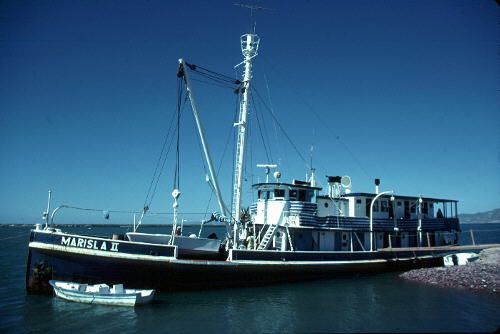 |
Chromodoris marislae
Chromodoris marislae Bertsch, 1973
"....This species is endemic to the central and southern Gulf of California, Mexico, in subtidal depths from 15 to 100 feet. Named after a boat (which is still afloat), its body color is off-white. On the dorsal surface are 2-3 irregular rows of orange spots peripherally, inside of which is an approximately circular grouping of larger orange ringlets, each surrounded or marked centrally with a frosty white margining. This distinctively brilliant white and orange coloration is most likely an aposematic or warning pattern. Its metabolic chemical defense (foul taste!) has been identified as marislin, derived from compounds in its sponge prey. Adult length is 2.5 to 3 inches. The 2 and 1/2 whorl egg mass is white, gently ruffled on its free edge..."
The above writeup was provided by Dr. Hans Bertsch early on in the formative years of the Slug Site. As Hans has indicated, the animal was named for a boat ( the Marisla II) based in La Paz, Baja California. This is one of the few instances if not the only instance where an branch was named for a boat. At the time of this posting, the Marisla II is barely afloat in La Paz after having been beached on rocks during a severe wind storm which are common place in that region. The boat is a story in itself as the reader will soon see!
San Diego, Calif
Sept. 2001
Photo of Marisla II taken at La Paz Harbor, circa 1980

|
"...I guess I always thought that Marisla was invincible. Getting close into the dive areas was always my motto. So it was that fateful night of June 2 and the dawn of June 3rd. The anchor was foolproof when properly deployed. The wind was howling, almost normal for the Chromwell wind of Summer. But a gust spun the ship around broadside to the wind and began dragging towards shore. Alarms told us of the news, and engines where on before we touched that solitary large rock. The pounding commenced and continued for the next five hours. We were committed to the beach, what with the now dropping tide.Sea water poured in through a gapping hole into the cargo (compressor) room area. The pumps seemed to be handling the job, but the sea won the battle.
Dr. Wright Cortner, our dear friend, and his family were off loaded onto our skiffs and taken to the next bay South, which was Pichilingue Harbor. We arranged for three taxis to haul the 14 along with all luggage to the Hotel Los Arcos. Then we dispatched the crew. Remaining were just to the two of us, crying our hearts out. The ship took a 14 degree list which allowed the sea water to pour into the engine room snuffing out our running light plant. Main engines had already been turned off.
The Mexican Navy took over the salvage at 8 am, finished getting the ship off the rock three days later and towed her to her place on our dock.
All arrangements are being made to tow her once again to Loreto for a
descent memorial service and sinking in a likely place for the creation
of the Marisla Reef. The mast will be allowed to raise above the
surface where a night light will be placed and a bronze plaque. In
Loreto, the hotels will be supplied with a well done folder describing
Marisla and her history. Letters from all who knew her will be
included..."
I for one am looking forward to visiting the Marisla in her final resting place at Loreto. Many fond memories of past trips are sure to be revisited while exploring the Marisla in her new role as an underwater reef. What more can be said, an ode to one of the best dive boats and skipper that ever sailed the Gulf of California!
